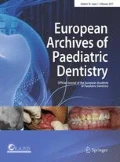Abstract
There is rarity of prevalence data on molar incisor hypomineralisation (MIH) for the Indian population and the majority of data originated from European countries.
Aim
To report on prevalence and defect characteristics of MIH for school children of the northern Indian region.
Methods
A cross-sectional survey including 1,792, 6–9-year-old school children of Chandigarh, India was carried out using European Academy of Paediatric Dentistry (EAPD) 2003 criteria for diagnosis of MIH. In addition to descriptive analysis for distribution of various defects, comparative data analysis was carried out for inter-comparison of distribution and type of defect amongst two phenotypes, MH [first permanent molar (FPMs) involvement] and M + IH (simultaneous involvement of molars and incisors). Similar comparative analysis was performed for four subgroups on the basis of number of affected surfaces/subjects.
Results
A prevalence of 6.31 % was reported. FPMs (2.83 ± 0.874/subject) were more commonly affected than permanent incisors (1.19 ± 1.614/subjects). White/creamy opacity without post-eruptive breakdown (PEB) was the most common lesion, seen in 85 % of subjects. MH phenotype was seen in 44 % of subjects and 56 % exhibited M + IH phenotype. A trend toward greater severity was seen in M + IH phenotype when compared to MH phenotype. A greater number of surfaces presented with white/creamy opacities without PEB (p < 0.05). With an increase in the number of surfaces involved the severity of MIH also increased with more frequent presence of brown defects with PEB.
Conclusion
With concomitant involvement of incisors, more severe presentation of MIH was seen. Also, with increase in number of affected surfaces a parallel increase in severity as well as extent of lesions was observed.
Similar content being viewed by others
References
Census of India 2011. http://censusindia.gov.in/PopulationFinder (accessed on 22nd November, 2012).
Chawla N, Messer LB, Silva M. Clinical studies on molar-incisor hypo-mineralisation. Part 1: distribution and putative associations. Eur Arch Paediatr Dent. 2008;9:180–90.
Cho SY, Ki Y, Chu V. Molar incisor hypomineralisation in Hong Kong Chinese children. Int J Paediatr Dent. 2008;18:348–52.
Dietrich G, Sperling S, Hetzer G. Molar incisor hypomineralisation in a group of children and adolescents living in Dresden (Germany). Eur J Paediatr Dent. 2003;4:133–7.
Elfrink MEC, Schuller AA, Weerheijm KL, Veerkamp JSJ. Hypomineralized second primary molars: prevalence data in Dutch 5-year-olds. Caries Res. 2008;42:282–5.
FDI Commission on Oral Health Research & Epidemiology. A review of the developmental defects of enamel index (DDE index). Int Dent J. 1992;42:411–26.
Ghanim A, Morgan M, Mariño R, Bailey D, Manton D. Molar-incisor hypomineralisation: prevalence and defect characteristics in Iraqi children. Int J Paediatr Dent. 2011;21:413–21.
Ghanim A, Manton D, Mariño R, Morgan M, Bailey D. Prevalence of demarcated hypomineralisation defects in second primary molars in Iraqi children. Int J Paediatr Dent. 2013;23:48–55.
Jälevik B, Norén JG. Enamel hypomineralisation of permanent first molars: a morphological study and survey of possible aetiological factors. Int J Paediatr Dent. 2000;10:278–89.
Jälevik B, Klingberg G, Barregård L, Norén JG. The prevalence of demarcated opacities in permanent first molars in a group of Swedish children. Acta Odontol Scand. 2001;59:255–60.
Jasulaityte L, Veerkamp JS, Weerheijm KL. Molar incisor hypomineralization: review and prevalence data from the study of primary school children in Kaunas/Lithuania. Eur Arch Paediatr Dent. 2007;8:87–94.
Koch G, Hallonsten AL, Ludvigsson N, et al. Epidemiologic study of idiopathic enamel hypomineralization in permanent teeth of Swedish children. Community Dent Oral Epidimiol. 1987;15:279–85.
Kuscu OO, Caglar E, Aslan S, et al. The prevalence of molar incisor hypomineralisation (MIH) in a group of children in a highly polluted urban region and a windfarm-green energy island. Int J Paediatr Dent. 2009;19:176–85.
Landis JR, Koch GG. The measurement of observer agreement for categorical data. Biometrics. 1977;33:159–74.
Leppäniemi A, Lukinmaa PL, Alaluusua S. Nonfluoride hypomineralizations in the permanent first molars and their impact on the treatment need. Caries Res. 2001;35:36–40.
Lygidakis NA, Dimou G, Briseniou E. Molar-incisor-hypomineralisation (MIH). Retrospective clinical study in Greek children. I. Prevalence and defect characteristics. Eur Arch Paediatr Dent. 2008a;9:200–6.
Lygidakis NA, Dimou G, Marinou D. Molar-incisor-hypomineralisation (MIH). A retrospective clinical study in Greek children. II. Possible medical aetiological factors. Eur Arch Paediatr Dent. 2008b;9:207–17.
Lygidakis NA, Wong F, Jälevik B, et al. Best Clinical Practice Guidance for clinicians dealing with children presenting with Molar-Incisor Hypomineralization (MIH). Eur Arch Paediatr Dent. 2010;11:75–81.
Mahoney EK, Rohanizadeh R, Ismail FSM, Kilpatrick NM, Swain MV. Mechanical properties and microstructure of hypomineralised enamel of permanent teeth. Biomaterials. 2004;25:5091–100.
Parikh DR, Ganesh M, Bhaskar V. Prevalence and characteristics of Molar Incisor Hypomineralisation (MIH) in the child population residing in Gandhinagar, Gujarat, India. Eur Arch Paediatr Dent. 2012;13:21–6.
Preusser SE, Ferring V, Wleklinski WE. Prevalence and severity of molar incisor hypomineralisation in a region of Germany—a brief communication. J Public Health Dent. 2007;67:148–50.
Soviero V, Haubek D, Trindade C, Matta TD, Poulsen S. Prevalence and distribution of demarcated opacities and their sequelae in permanent 1st molars and incisors in 7 to 13-year-old Brazilian children. Acta Odontol Scand. 2009;67:170–5.
van Amerongen WE, Kreulen CM. Cheese molars: a pilot study of the etiology of hypocalcifications in first permanent molars. ASDC J Dent Child. 1995;62:266–9.
Weerheijm L, Jälevik B, Alaluusua S. Molar-incisor hypomineralization. Caries Res. 2001;35:390–1.
Weerheijm KL, Mejare I. Molar incisor hypomineralisation: a questionnaire inventory of its occurrence in member countries of the European Academy of Paediatric Dentistry (EAPD). Int J Paediatr Dent. 2003;13:411–6.
Weerheijm KL. Molar incisor hypomineralization (MIH): clinical presentation, aetiology and management. Dent Update. 2004;31:9–12.
Wogelius P, Haubek D, Poulsen S. Prevalence and distribution of demarcated opacities in permanent 1st molars and incisors in 6 to 8-years-old Danish children. Acta Odontol Scand. 2008;66:58–64.
Zawaideh FI, Al-Jundi SH, Al-Jaljoli MH. Molar incisor hypomineralisation: prevalence in Jordanian children and clinical characteristics. Eur Arch Paediatr Dent. 2011;12:31–3.
Author information
Authors and Affiliations
Corresponding author
Rights and permissions
About this article
Cite this article
Mittal, N.P., Goyal, A., Gauba, K. et al. Molar incisor hypomineralisation: prevalence and clinical presentation in school children of the northern region of India. Eur Arch Paediatr Dent 15, 11–18 (2014). https://doi.org/10.1007/s40368-013-0045-4
Received:
Accepted:
Published:
Issue Date:
DOI: https://doi.org/10.1007/s40368-013-0045-4




